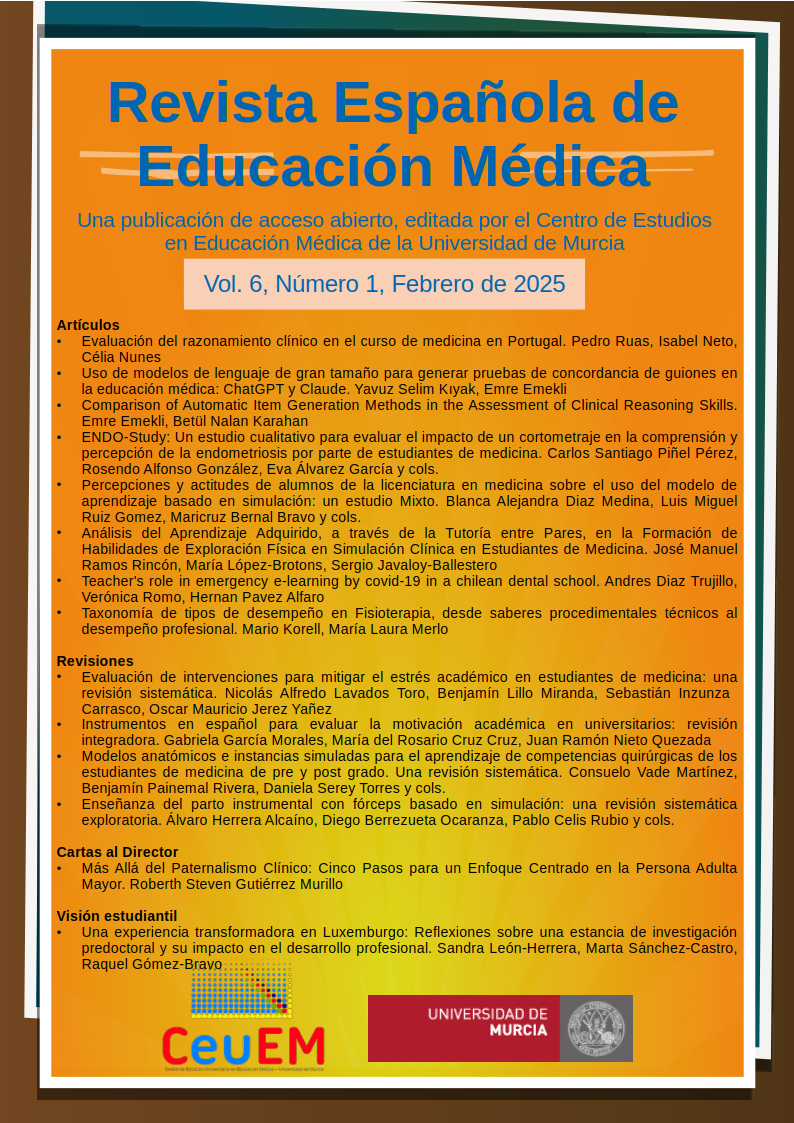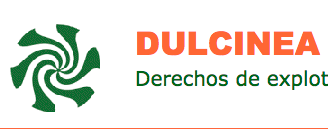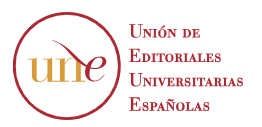Enseñanza del parto instrumental con fórceps basado en simulación: una revisión sistemática exploratoria
Resumen
Introducción: La adquisición de habilidades para la atención de partos instrumentalizados con fórceps se ha vuelto más desafiante debido a la disminución de la tasa de partos instrumentales a nivel mundial. Por lo tanto, se ha vuelto fundamental optimizar las estrategias y métodos de enseñanza de estos procedimientos en los residentes de Obstetricia y Ginecología. Objetivo: Exponer los métodos de enseñanza reportados en la literatura para la atención de partos con fórceps y su contribución al aprendizaje y adquisición de habilidades en residentes. Material y métodos: Revisión sistemática de la literatura mediante el protocolo PRISMA Extension for Scoping Reviews en la base de datos de WOS y SCOPUS. Se consideraron artículos originales publicados en español e inglés, sin delimitación temporal, referidos a los métodos o modelos de enseñanza de atención de partos instrumentalizados con fórceps. Se seleccionaron aquellos artículos de acuerdo con el objetivo de la investigación. Los autores revisaron y sintetizaron de forma independiente la información de los artículos incluidos. Resultados: Seis estudios fueron revisados y organizados en tres categorías: i) Tipos de método de enseñanza: destacaron las simulaciones de alta y baja fidelidad, así como métodos integrativos de simulaciones y clases teóricas. ii) Efectividad en la adquisición de habilidades y percepciones de los participantes: se evidenciaron progresos en habilidades técnicas, mayor confianza y satisfacción por parte de los residentes, además de mejores resultados clínicos. iii) Patrones y desarrollo de herramientas educativas: los simuladores avanzados permitieron replicar escenarios clínicos y optimizar las fuerzas aplicadas durante el procedimiento, además la retroalimentación inmediata permite perfeccionar la corrección de errores. Conclusiones: Esta revisión destaca la importancia de los métodos de enseñanza basados en simulación y currículos educativos estructurados para mejorar tanto las habilidades técnicas como la confianza de los residentes en la ejecución de partos instrumentales con fórceps.
Descargas
Métricas
-
Resumen620
-
pdf376
-
Anexo I33
-
pdf 376
-
Annex I 29
Citas
Black M, Murphy DJ. Forceps delivery for non-rotational and rotational operative vaginal delivery. Best Pract Res Clin Obstet Gynaecol. 2019, 56, 55-68. https://doi.org/10.1016/j.bpobgyn.2019.02.002.
Lopéz-Aceitón M, Espinosa-Serrano M, Guzmán-Rojas R. Experiencia de parto instrumental con vacuum en Hospital Público de Santiago de Chile. Rev Chil Obstet Ginecol. 2024, 89(1), 25-31. https://doi.org/10.24875/rechog.23000098.
Cunningham, F. G., Leveno, K. J., Bloom, S. L., Dashe, J. S., Hoffman, B. L., Spong, C. Y., & Sheffield, J. S. (2022). Chapter 29: Operative vaginal delivery. Williams Obstetrics (26.ª ed.). McGraw-Hill.
Rozo-Agudelo N, Daza-Barrera SC. Estimated frequency of instrumented vaginal delivery in Colombia between 2015 and 2019: Population registry-based cross-sectional study. Rev Colomb Obstet Ginecol. 2022, 73(4), 358-368. https://doi.org/10.18597/rcog.3878.
American College of Obstetricians and Gynecologists. Ethical Decision Making in Obstetrics and Gynecology. ACOG Committee Opinion No. 390. Obstet Gynecol. 2007, 110(6), 1479-1487. https://www.acog.org/clinical/clinical-guidance/committee-opinion/articles/2007/12/ethical-decision-making-in-obstetrics-and-gynecology
Ashcroft J, Blakely C, Wong MD. Nonmaleficence in Medical Training: Balancing Patient Safety and Trainee Education. Int J Med Educ. 2019, 10, 207-212. https://doi.org/10.5116/ijme.5d9e.8f08
United Nations Department of Economic and Social Affairs, Population Division. World Population Prospects 2022: Summary of Results. UN DESA/POP/2022/TR/NO. 3; 2022. Accessed [2024 Oct 1]. https://www.un.org/development/desa/pd/sites/www.un.org.development.desa.pd/files/wpp2022_summary_of_results.pdf
National Center for Health Statistics. Vital statistics data available online: Natality public use file and CD-ROM. Hyattsville, MD: U.S. Department of Health and Human Services; 1990. Available at: http://www.cdc.gov/nchs/data_access/VitalStatsOnline.htm. Accessed [2024 Oct 1].
National Center for Health Statistics. Vital statistics data available online: Natality public use file and CD-ROM. Hyattsville, MD: U.S. Department of Health and Human Services; 2015. Available at: http://www.cdc.gov/nchs/data_access/VitalStatsOnline.htm. Accessed [2024 Oct 1].
Zhou Y, Li H, Zhu L, Li Z, Zhang Y, Liu J. [Secular trends of operative vaginal delivery in southern and northern China during 1993-2010]. Zhonghua Yi Xue Za Zhi. 2014, 94(45), 3599-602. Chinese. https://caod.oriprobe.com/articles/43566063/Secular_trends_of_operative_vaginal_delivery_in_so.htm
Wang B, Shi Q, Wang Y, Li N, Shi L. National survey on midwifery practice in health facilities in China. Chin J Obstet Gynecol. 2007, 42, 305–308. https://pubmed.ncbi.nlm.nih.gov/17673041/
Hou L, Li G, Zou L, et al. Cesarean delivery rate and indications in mainland China: a cross sectional study in 2011. Chin J Obstet Gynecol. 2014, 49, 728–735. https://pubmed.ncbi.nlm.nih.gov/25537242/
Euro-Peristat Project. European Perinatal Health Report. Core indicators of the health and care of pregnant women and babies in Europe in 2015. 2018. Available at: www.europeristat.com. Accessed [2024 Oct 1].
Euro-Peristat Project. European Perinatal Health Report. Core indicators of the health and care of pregnant women and babies in Europe from 2015 to 2019. 2020. Available at: www.europeristat.com. Accessed [2024 Oct 1].
Martin JA, Hamilton BE, Osterman MJK, Driscoll AK, Drake P. Births: Final Data for 2016. Natl Vital Stat Rep. 2018, 67(1), 1-55. https://www.cdc.gov/nchs/data/nvsr/nvsr67/nvsr67_01.pdf
Osterman MJK, Martin JA. Trends in low-risk cesarean delivery in the United States, 1990-2013. Natl Vital Stat Rep. 2014, 63(6), 1-16. https://pubmed.ncbi.nlm.nih.gov/25383560/
Hamilton BE, Martin JA, Osterman MJK. Births: Provisional data for 2023. Vital Statistics Rapid Release. 2024, (35). https://doi.org/10.15620/cdc/151797. https://www.cdc.gov/nchs/data/vsrr/vsrr035.pdf
Kozhimannil KB, Law MR, Virnig BA. Cesarean delivery rates vary tenfold among US hospitals: reducing variation may address quality and cost issues. Health Aff (Millwood). 2013, 32(3), 527-535. https://doi.org/10.1377/hlthaff.2013.0001.
American College of Obstetricians and Gynecologists; Society of Maternal-Fetal Medicine; Caughey AB, Cahill AG, Guise JM, Rouse DJ. Safe prevention of the primary cesarean delivery. Am J Obstet Gynecol. 2014, 123(3), 693-711. https://doi.org/10.1016/j.ajog.2014.01.026
Hirshberg A, Srinivas SK. Role of operative vaginal deliveries in prevention of cesarean deliveries. Clin Obstet Gynecol. 2015, 58(2), 256-262. https://doi.org/10.1097/GRF.0000000000000107
O’Mahony F, Hofmeyr GJ, Menon V. Choice of instruments for assisted vaginal delivery. Cochrane Database Syst Rev. 2010, (11), CD005455. https://doi.org/10.1002/14651858.CD005455.pub2.
Rose K, Kwan L, Pluym ID, Zhang H, Han CS, Afshar Y. Forceps-assisted vaginal delivery: the landscape of obstetrics and gynecology resident training. J Matern Fetal Neonatal Med. 2019, 34(18), 3039–3045. https://doi.org/10.1080/14767058.2019.1677593.
Dotters-Katz SK, Gray B, Heine RP, Propst K. Resident Education in Complex Obstetric Procedures: Are We Adequately Preparing Tomorrow's Obstetricians?. Am J Perinatol. 2020, 37(11), 1155-1159. https://doi.org/10.1055/s-0039-1692714
Bennett C, Chambers LM, Yao M, Chien E, Berghella V. Reported case numbers and variability in delivery route and volume by obstetrics and gynecology residents from 2003 to 2019. Am J Obstet Gynecol MFM. 2021, 3(5), 100398. https://doi.org/10.1016/j.ajogmf.2021.100398.
Accreditation Council for Graduate Medical Education. Obstetrics and Gynecology Case Logs: National Data Report (2022-2023). Chicago, IL: Accreditation Council for Graduate Medical Education; 2023. https://apps.acgme.org/ads/Public/Reports/CaselogNationalReportDownload?specialtyId=40&academicYearId=29. Accessed [2024 Oct 1].
Accreditation Council For Graduate Medical Education. Minimum numbers: obstetrics and gynaecology. J Grad Medical Education. 2018. https://www.acgme.org/globalassets/pfassets/programresources/ obgyncaseloginfo.pdf (2022).
Andrews SE, Alston MJ, Allshouse AA, Moore GS, Metz TD. Does the number of forceps deliveries performed in residency predict use in practice?. Am J Obstet Gynecol. 2015, 213(1), 93.e1-93.e4. https://doi.org/10.1016/j.ajog.2015.03.025
Dávila-Cervantes A. Simulación en Educación Médica. Investig Educ Méd. 2014, 3(10), 100-105. https://doi.org/10.1016/S2007-5057(14)72733-4.
Rognoni G, Benet P, Castro A, Gomar S, Villalonga R, Zorrilla J. La simulación clínica en la educación médica: Ventajas e inconvenientes del aprendizaje al lado del paciente y en entorno simulado. Med Clin Pract. 2024, 7, 100459. https://doi.org/10.1016/j.mcpsp.2024.100459.
Satin AJ. Simulation in obstetrics. Obstet Gynecol. 2018 ,132(1), 199–209. https://doi.org/10.1097/AOG.0000000000002682.
Tricco AC, Lillie E, Zarin W, et al. PRISMA Extension for Scoping Reviews (PRISMA-ScR): Checklist and Explanation. Ann Intern Med. 2018, 169(7), 467-473. https://doi.org/10.7326/M18-0850
Daniels K, Lipman S, Harney K, Arafeh J, Druzin M. Use of simulation based team training for obstetric crises in resident education. Simul Healthc. 2008, 3(3), 154-160. https://doi.org/10.1097/SIH.0b013e31818187d9
Moreau R, Pham MT, Brun X, Redarce T, Dupuis O. Simulation of an instrumental childbirth for the training of the forceps extraction: control algorithm and evaluation. IEEE Trans Inf Technol Biomed. 2011, 15(3), 364-372. https://doi.org/10.1109/TITB.2011.2107746
Rose K, Jensen K, Guo R, Afshar Y. Simulation to Improve Trainee Skill and Comfort with Forceps-Assisted Vaginal Deliveries. AJP Rep. 2019, 9(1), e6-e9. https://doi.org/10.1055/s-0039-1677736
Becker DA, Blanchard CT, Szychowski JM, Rogers SL, Brumfield CG, Subramaniam A. Resident Operative Vaginal Delivery Volume after Educational Curriculum Implementation. Am J Perinatol. 2020, 37(13), 1296-1300. https://doi.org/10.1055/s-0040-1710543
Gossett DR, Gilchrist-Scott D, Wayne DB, Gerber SE. Simulation Training for Forceps-Assisted Vaginal Delivery and Rates of Maternal Perineal Trauma. Obstet Gynecol. 2016, 128(3), 429-435. https://doi.org/10.1097/AOG.0000000000001533
Wang X, Song Z, Chen X, et al. Rapid cycle deliberate practice: application in forceps simulation training for gynecology and obstetrics residents. Ann Med. 2024, 56(1), 2301596. https://doi.org/10.1080/07853890.2023.2301596
Zeng Q, Wang K, Liu W, et al. Efficacy of high-fidelity simulation in advanced life support training: a systematic review and meta-analysis of randomized controlled trials. BMC Med Educ. 2023, 23, 664. https://doi.org/10.1186/s12909-023-04654-x.
Moya P, Ruz M, Parraguez E, Carreño V, Rodríguez AM, Froes P. Efectividad de la simulación en la educación médica desde la perspectiva de seguridad de pacientes. Rev Med Chil. 2017, 145(4), 514-526. https://doi.org/10.4067/S0034-98872017000400012.
Broch M, Castellanos-Ortega Á. Seguridad del paciente, ¿qué aportan la simulación clínica y la innovación docente? Med Intensiva. 2024. https://doi.org/10.1016/j.medin.2024.03.017
American College of Obstetricians and Gynecologists. ACOG Practice Bulletin No. 198: Prevention and Management of Obstetric Lacerations at Vaginal Delivery. Obstet Gynecol. 2018, 132(3), e87-e102. https://doi.org/10.1097/AOG.0000000000002841.
Magee MJ, Farkouh-Karoleski C, Rosen TS. Improvement of Immediate Performance in Neonatal Resuscitation Through Rapid Cycle Deliberate Practice Training. J Grad Med Educ. 2018, 10(2), 192-197. https://doi.org/10.4300/JGME-D-17-00467.1
Swinger N, Hocutt G, Medsker BH, et al. Rapid cycle deliberate practice versus traditional simulation for training extracorporeal membrane oxygenation specialists in circuit air emergency management: a randomized trial. Simul Healthc. 2022, 17(1), e28–e37. https://doi.org/10.1097/SIH.0000000000000562
Kaczorowski J, Levitt C, Hammond M, et al. Retention of neonatal resuscitation skills and knowledge: a randomized controlled trial. Fam Med. 1998, 30(10), 705-711. https://pubmed.ncbi.nlm.nih.gov/9827341/
Derechos de autor 2024 Servicio de Publicaciones de la Universidad de Murcia

Esta obra está bajo una licencia internacional Creative Commons Atribución-NoComercial-SinDerivadas 4.0.
Las obras que se publican en esta revista están sujetas a los siguientes términos:
1. El Servicio de Publicaciones de la Universidad de Murcia (la editorial) conserva los derechos patrimoniales (copyright) de las obras publicadas y favorece y permite la reutilización de las mismas bajo la licencia de uso indicada en el punto 2.
© Servicio de Publicaciones, Universidad de Murcia
2. Las obras se publican bajo una licencia Creative Commons Reconocimiento-NoComercial-SinObraDerivada 4.0.
![]()
3. Condiciones de auto-archivo. Se permite y se anima a los autores a difundir electrónicamente las versiones preprint (versión antes de ser evaluada y enviada a la revista) y/o post-print (versión evaluada y aceptada para su publicación) de sus obras antes de su publicación, ya que favorece su circulación y difusión más temprana y con ello un posible aumento en su citación y alcance entre la comunidad académica.




















